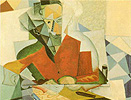<< texts
Published in the catalogue Diego Rivera in Spain: Cubist images, Spanish Cultural Centre, Mexico, 2003
Diego Rivera in
Spain: Cubist images.




Spain and Mexico have been splendid scenarios for the exchange of virtues and creations, which have gone from trip to trip; brought to Mexican land by Spaniards and taken to Spanish land by Mexicans. This exhibition is based on the idea of trip as a formative experience. For artists, trips determine the works that later we preserve as heritage. At the same time, it is a bet on putting the accent on a little known but decisive period of Diego Rivera´s work (Cubism, linked to his stay and friends in Spain, where the most outstanding was Ramón Gómez de la Serna). It is also a particular reading present even in the museography: the colour of the walls avoids neutrality, the documentary information becomes more important and some rules are subverted in order to lead visitors towards an intense and amusing experience.
The years that Diego Rivera spent in Spain were crucial for his aesthetic virtues to grow. In spite of his youth, Rivera already was a consummate painter when he arrived to Madrid in 1907. He went to the famous painter Eduardo Chicharro`s studio with a letter of introduction by Dr. Atl. The young artist had a full technical knowledge of painting after seven disciplined years of study in the San Carlos Academy. He didn`t need expertise, but to look for himself in order to begin a new personal style.
Rivera repeatedly visited the Museo del Prado, where he could have contact with works by El Greco, Velázquez and Goya. From them he could learn valuable lessons that remained indelible in his mind and were a part of his very personal style during his maturity. While Rivera studied, he also became absorbed by the Madrid bohemia and the literary and artistic avant-garde, which prepared him to make a triumphant entrance into Paris life. Ramón del Valle Inclán, who belonged to the group of Spanish intellectuals that Rivera knew, advised him to move away from descriptive painting and develop a creative image, settled in the poetic and even spiritual aspect of the symbols.
In the Fall of 1910 Rivera briefly visited Mexico, successfully exhibiting the works produced during his first stay in Spain. When he went back to Europe, he stopped in Barcelona before going to Paris. There he painted some landscapes in which the ideas about geometry that later took him to Cubism were already present. In 1912 Diego threw himself into painting popular Spanish characters and peasants, deliberately Expressionist. He also choosed the austere, craggy and arid Spanish landscapes. His stay in Toledo gave him cause for thinking about the wide and barren spaces which he translated as large, flat and geometrical surfaces that seem to be closer to Cubism.
Diego Rivera's maturity and autonomy inside Cubism occurred when he lived in Paris, developing the "Cubism of Anáhuac", as Alfonso Reyes named it. Rivera included pieces of Saltillo sarapes, a totally strange element for the repertory of forms and colours of Paris Cubism. This exotic contribution allowed Rivera to reinforce his Mexican identity. The Rivera`s easel painting outlook was enriched to a great extent with his Cubist adventure, and also his personality, because he achieved a personalized Cubism. This process occured during his intermittent two-year stay in different regions of Spain.
Stays of Rivera in Spain
January 6, 1907 - March 1909
Thanks to the grant received from the Governor of Veracruz, Teodoro Dehesa, Rivera joins the studio of the Spanish painter Eduardo Chicharro and travels throughout Spain with him. He makes copies in the Museo del Prado and becomes friends with Ramón Gómez de la Serna, Ramón de Valle-Inclán and María Gutiérrez Blanchard.
June 1910 - October 2nd, 1910
In Madrid, he prepares his exhibiton at the Academia de San Carlos in Mexico.
Spring 1912 - Fall 1912
He travels to Toledo with Angelina Beloff, his first wife, and studies El Greco and Zuloaga.
Fall 1912 - January 1913
He returns to Toledo in order to prepare the exhibition "Groupe libre" at the Galerie Bernheim-Jeune in Paris. He makes his first cubist works.
January 1913 - Summer 1913
Again in Toledo, he finishes some unresolved paintings.
Summer 1914 - Spring 1915
The World War I caught him on travel through the island of Mallorca, from there he goes to Barcelona and Madrid. Gómez de la Serna includes him on the exhibition "The upright painters".
This work is licensed under a Creative Commons Attribution-Noncommercial-No Derivative Works 3.0 License.
info@anderazpiri.com